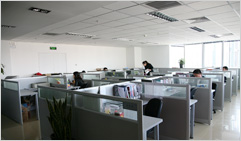Traditional Chinese Massage
 Massage, in Chinese is called 'an mo' or 'tui na', and is another great contribution the Chinese have made to the world medical field. It is a kind of outer physiotherapy and has been proven to be one of great practical use. This marvelous treatment as a method of Chinese medicine has a long and interesting history. The earliest recorded massage is the inscriptions on bones or tortoise shells of the Shang Dynasty (16th -11th century BC). During the Spring and Autumn Period (770 - 476 BC), a story exists and was recorded of a marvelous doctor, Bian Que, who healed a faint prince through massage, illustrating it's miraculous effects. In the Northern and Southern Dynasties (386 - 589), six techniques of hand massage evolved and came into common usage as the basis of the profession. These were strand, shake, twine, twiddle, knead and roll.
Massage, in Chinese is called 'an mo' or 'tui na', and is another great contribution the Chinese have made to the world medical field. It is a kind of outer physiotherapy and has been proven to be one of great practical use. This marvelous treatment as a method of Chinese medicine has a long and interesting history. The earliest recorded massage is the inscriptions on bones or tortoise shells of the Shang Dynasty (16th -11th century BC). During the Spring and Autumn Period (770 - 476 BC), a story exists and was recorded of a marvelous doctor, Bian Que, who healed a faint prince through massage, illustrating it's miraculous effects. In the Northern and Southern Dynasties (386 - 589), six techniques of hand massage evolved and came into common usage as the basis of the profession. These were strand, shake, twine, twiddle, knead and roll.  Although these original techniques are still used today, the field of massage has evolved to include over 20 techniques, and it is still an evolving field. Different levels of massage can be achieved depending in the strength and direction of the hand, affecting from skin to pulse and muscle, even to the bone marrow. Today massage is widely practiced and taught in hospitals and medical schools and is an important part of primary healthcare. The development of the Chinese traditional massage came from the cooperation between four groups: doctors who brought the sophisticated medical theories of traditional Chinese medicine (TCM) to massage, martial artists who combined experience of Qi with the ability to heal injuries, Buddhist and Taoist adepts who used massage as an essential part of their spiritual yoga and often blind layman practitioners who offered massage for pleasure and relaxation.
Although these original techniques are still used today, the field of massage has evolved to include over 20 techniques, and it is still an evolving field. Different levels of massage can be achieved depending in the strength and direction of the hand, affecting from skin to pulse and muscle, even to the bone marrow. Today massage is widely practiced and taught in hospitals and medical schools and is an important part of primary healthcare. The development of the Chinese traditional massage came from the cooperation between four groups: doctors who brought the sophisticated medical theories of traditional Chinese medicine (TCM) to massage, martial artists who combined experience of Qi with the ability to heal injuries, Buddhist and Taoist adepts who used massage as an essential part of their spiritual yoga and often blind layman practitioners who offered massage for pleasure and relaxation.My Questions *We welcome and appreciate your questions & reviews



